Chronic Illness Care and Patient Empowerment
VerifiedAdded on 2020/03/23
|8
|2957
|86
AI Summary
This assignment delves into the multifaceted aspects of caring for patients with chronic illnesses. It emphasizes the importance of patient empowerment through self-management techniques, encouraging active participation in their healthcare journey. The focus extends to collaborative care models involving nurses, physicians, and other healthcare professionals, highlighting the benefits of interdisciplinary teamwork in managing complex health conditions. Key concepts such as integrated care, web-based interventions, and the role of technology in supporting patients are also explored.
Contribute Materials
Your contribution can guide someone’s learning journey. Share your
documents today.
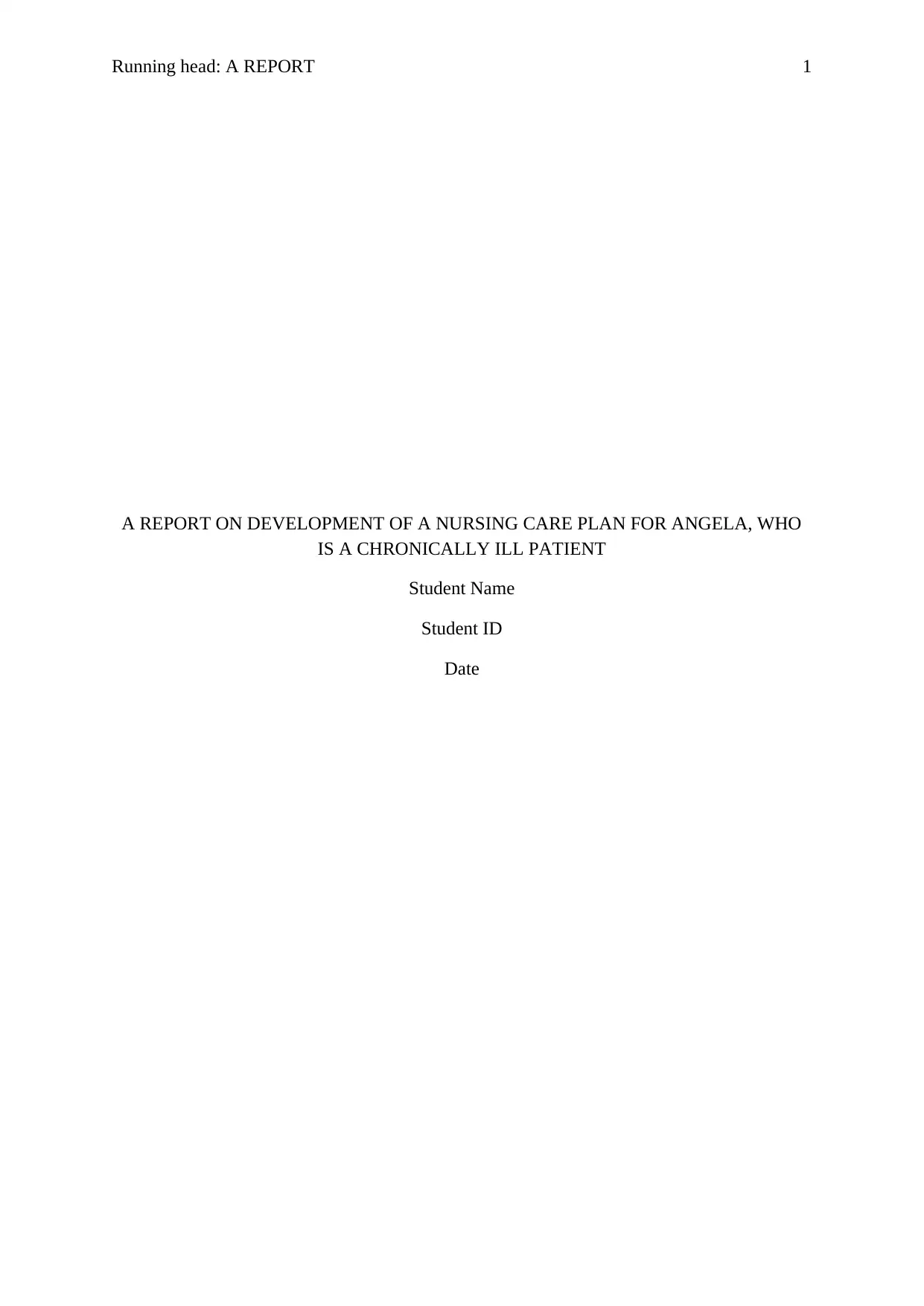
Running head: A REPORT 1
A REPORT ON DEVELOPMENT OF A NURSING CARE PLAN FOR ANGELA, WHO
IS A CHRONICALLY ILL PATIENT
Student Name
Student ID
Date
A REPORT ON DEVELOPMENT OF A NURSING CARE PLAN FOR ANGELA, WHO
IS A CHRONICALLY ILL PATIENT
Student Name
Student ID
Date
Secure Best Marks with AI Grader
Need help grading? Try our AI Grader for instant feedback on your assignments.
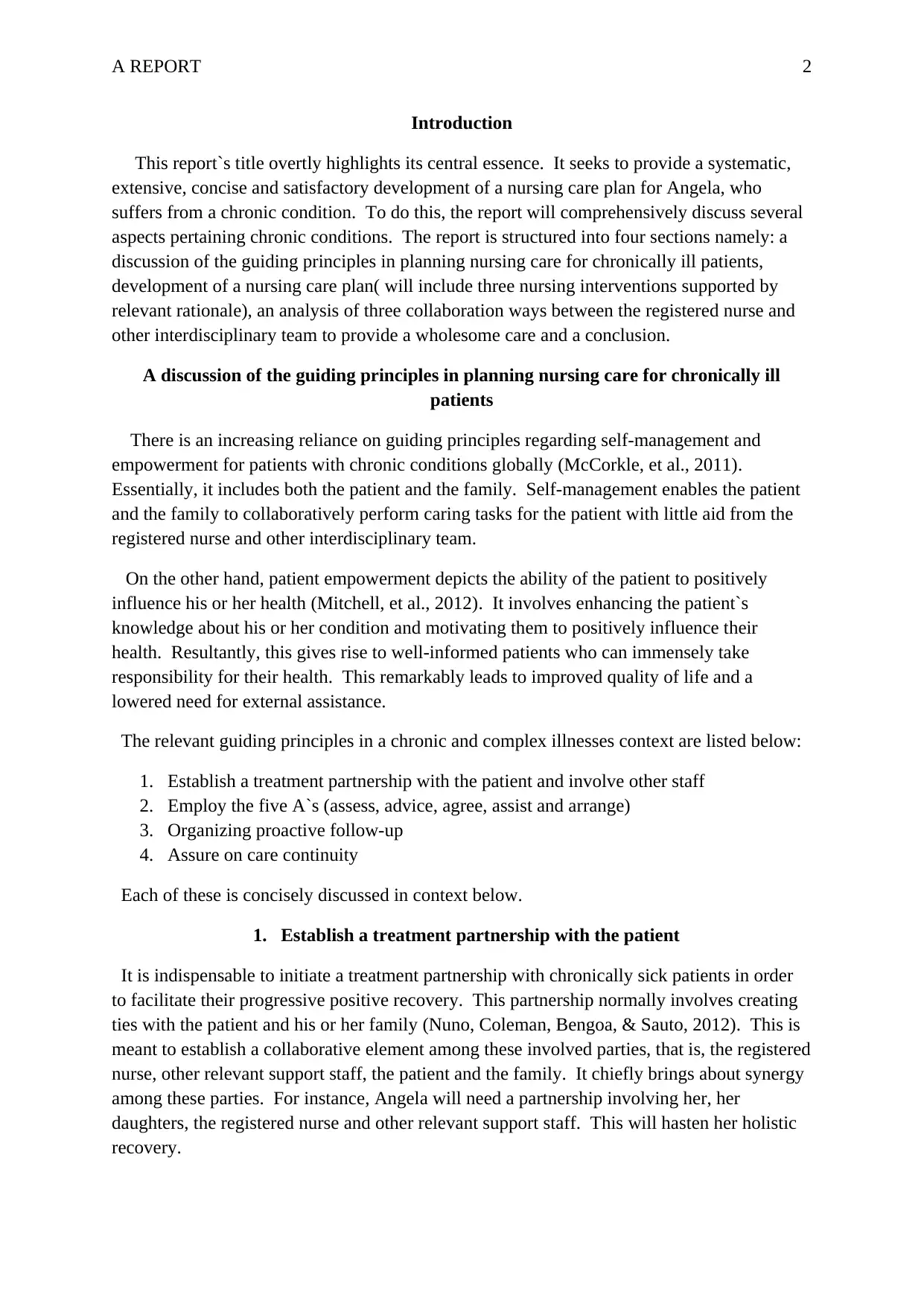
A REPORT 2
Introduction
This report`s title overtly highlights its central essence. It seeks to provide a systematic,
extensive, concise and satisfactory development of a nursing care plan for Angela, who
suffers from a chronic condition. To do this, the report will comprehensively discuss several
aspects pertaining chronic conditions. The report is structured into four sections namely: a
discussion of the guiding principles in planning nursing care for chronically ill patients,
development of a nursing care plan( will include three nursing interventions supported by
relevant rationale), an analysis of three collaboration ways between the registered nurse and
other interdisciplinary team to provide a wholesome care and a conclusion.
A discussion of the guiding principles in planning nursing care for chronically ill
patients
There is an increasing reliance on guiding principles regarding self-management and
empowerment for patients with chronic conditions globally (McCorkle, et al., 2011).
Essentially, it includes both the patient and the family. Self-management enables the patient
and the family to collaboratively perform caring tasks for the patient with little aid from the
registered nurse and other interdisciplinary team.
On the other hand, patient empowerment depicts the ability of the patient to positively
influence his or her health (Mitchell, et al., 2012). It involves enhancing the patient`s
knowledge about his or her condition and motivating them to positively influence their
health. Resultantly, this gives rise to well-informed patients who can immensely take
responsibility for their health. This remarkably leads to improved quality of life and a
lowered need for external assistance.
The relevant guiding principles in a chronic and complex illnesses context are listed below:
1. Establish a treatment partnership with the patient and involve other staff
2. Employ the five A`s (assess, advice, agree, assist and arrange)
3. Organizing proactive follow-up
4. Assure on care continuity
Each of these is concisely discussed in context below.
1. Establish a treatment partnership with the patient
It is indispensable to initiate a treatment partnership with chronically sick patients in order
to facilitate their progressive positive recovery. This partnership normally involves creating
ties with the patient and his or her family (Nuno, Coleman, Bengoa, & Sauto, 2012). This is
meant to establish a collaborative element among these involved parties, that is, the registered
nurse, other relevant support staff, the patient and the family. It chiefly brings about synergy
among these parties. For instance, Angela will need a partnership involving her, her
daughters, the registered nurse and other relevant support staff. This will hasten her holistic
recovery.
Introduction
This report`s title overtly highlights its central essence. It seeks to provide a systematic,
extensive, concise and satisfactory development of a nursing care plan for Angela, who
suffers from a chronic condition. To do this, the report will comprehensively discuss several
aspects pertaining chronic conditions. The report is structured into four sections namely: a
discussion of the guiding principles in planning nursing care for chronically ill patients,
development of a nursing care plan( will include three nursing interventions supported by
relevant rationale), an analysis of three collaboration ways between the registered nurse and
other interdisciplinary team to provide a wholesome care and a conclusion.
A discussion of the guiding principles in planning nursing care for chronically ill
patients
There is an increasing reliance on guiding principles regarding self-management and
empowerment for patients with chronic conditions globally (McCorkle, et al., 2011).
Essentially, it includes both the patient and the family. Self-management enables the patient
and the family to collaboratively perform caring tasks for the patient with little aid from the
registered nurse and other interdisciplinary team.
On the other hand, patient empowerment depicts the ability of the patient to positively
influence his or her health (Mitchell, et al., 2012). It involves enhancing the patient`s
knowledge about his or her condition and motivating them to positively influence their
health. Resultantly, this gives rise to well-informed patients who can immensely take
responsibility for their health. This remarkably leads to improved quality of life and a
lowered need for external assistance.
The relevant guiding principles in a chronic and complex illnesses context are listed below:
1. Establish a treatment partnership with the patient and involve other staff
2. Employ the five A`s (assess, advice, agree, assist and arrange)
3. Organizing proactive follow-up
4. Assure on care continuity
Each of these is concisely discussed in context below.
1. Establish a treatment partnership with the patient
It is indispensable to initiate a treatment partnership with chronically sick patients in order
to facilitate their progressive positive recovery. This partnership normally involves creating
ties with the patient and his or her family (Nuno, Coleman, Bengoa, & Sauto, 2012). This is
meant to establish a collaborative element among these involved parties, that is, the registered
nurse, other relevant support staff, the patient and the family. It chiefly brings about synergy
among these parties. For instance, Angela will need a partnership involving her, her
daughters, the registered nurse and other relevant support staff. This will hasten her holistic
recovery.
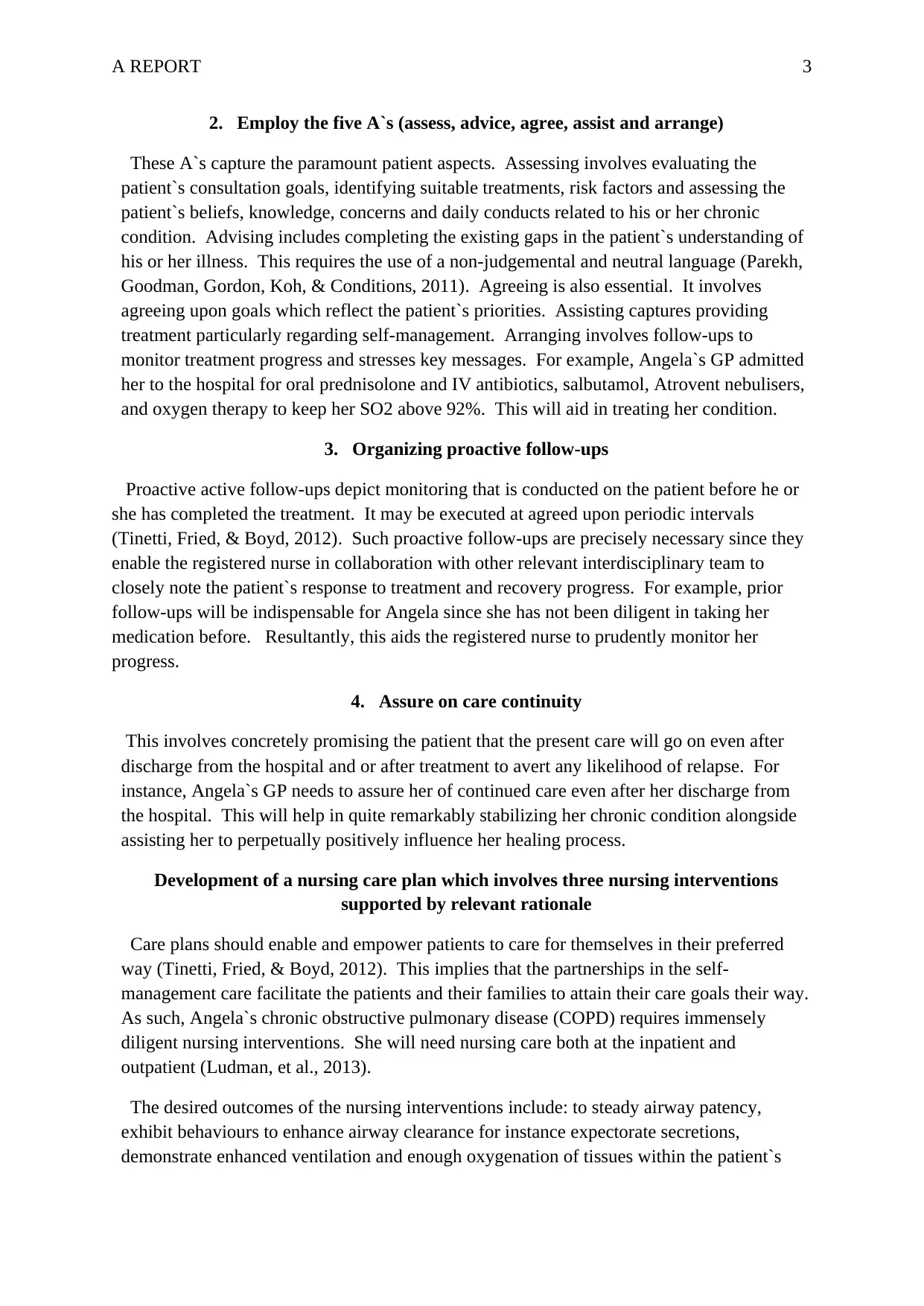
A REPORT 3
2. Employ the five A`s (assess, advice, agree, assist and arrange)
These A`s capture the paramount patient aspects. Assessing involves evaluating the
patient`s consultation goals, identifying suitable treatments, risk factors and assessing the
patient`s beliefs, knowledge, concerns and daily conducts related to his or her chronic
condition. Advising includes completing the existing gaps in the patient`s understanding of
his or her illness. This requires the use of a non-judgemental and neutral language (Parekh,
Goodman, Gordon, Koh, & Conditions, 2011). Agreeing is also essential. It involves
agreeing upon goals which reflect the patient`s priorities. Assisting captures providing
treatment particularly regarding self-management. Arranging involves follow-ups to
monitor treatment progress and stresses key messages. For example, Angela`s GP admitted
her to the hospital for oral prednisolone and IV antibiotics, salbutamol, Atrovent nebulisers,
and oxygen therapy to keep her SO2 above 92%. This will aid in treating her condition.
3. Organizing proactive follow-ups
Proactive active follow-ups depict monitoring that is conducted on the patient before he or
she has completed the treatment. It may be executed at agreed upon periodic intervals
(Tinetti, Fried, & Boyd, 2012). Such proactive follow-ups are precisely necessary since they
enable the registered nurse in collaboration with other relevant interdisciplinary team to
closely note the patient`s response to treatment and recovery progress. For example, prior
follow-ups will be indispensable for Angela since she has not been diligent in taking her
medication before. Resultantly, this aids the registered nurse to prudently monitor her
progress.
4. Assure on care continuity
This involves concretely promising the patient that the present care will go on even after
discharge from the hospital and or after treatment to avert any likelihood of relapse. For
instance, Angela`s GP needs to assure her of continued care even after her discharge from
the hospital. This will help in quite remarkably stabilizing her chronic condition alongside
assisting her to perpetually positively influence her healing process.
Development of a nursing care plan which involves three nursing interventions
supported by relevant rationale
Care plans should enable and empower patients to care for themselves in their preferred
way (Tinetti, Fried, & Boyd, 2012). This implies that the partnerships in the self-
management care facilitate the patients and their families to attain their care goals their way.
As such, Angela`s chronic obstructive pulmonary disease (COPD) requires immensely
diligent nursing interventions. She will need nursing care both at the inpatient and
outpatient (Ludman, et al., 2013).
The desired outcomes of the nursing interventions include: to steady airway patency,
exhibit behaviours to enhance airway clearance for instance expectorate secretions,
demonstrate enhanced ventilation and enough oxygenation of tissues within the patient`s
2. Employ the five A`s (assess, advice, agree, assist and arrange)
These A`s capture the paramount patient aspects. Assessing involves evaluating the
patient`s consultation goals, identifying suitable treatments, risk factors and assessing the
patient`s beliefs, knowledge, concerns and daily conducts related to his or her chronic
condition. Advising includes completing the existing gaps in the patient`s understanding of
his or her illness. This requires the use of a non-judgemental and neutral language (Parekh,
Goodman, Gordon, Koh, & Conditions, 2011). Agreeing is also essential. It involves
agreeing upon goals which reflect the patient`s priorities. Assisting captures providing
treatment particularly regarding self-management. Arranging involves follow-ups to
monitor treatment progress and stresses key messages. For example, Angela`s GP admitted
her to the hospital for oral prednisolone and IV antibiotics, salbutamol, Atrovent nebulisers,
and oxygen therapy to keep her SO2 above 92%. This will aid in treating her condition.
3. Organizing proactive follow-ups
Proactive active follow-ups depict monitoring that is conducted on the patient before he or
she has completed the treatment. It may be executed at agreed upon periodic intervals
(Tinetti, Fried, & Boyd, 2012). Such proactive follow-ups are precisely necessary since they
enable the registered nurse in collaboration with other relevant interdisciplinary team to
closely note the patient`s response to treatment and recovery progress. For example, prior
follow-ups will be indispensable for Angela since she has not been diligent in taking her
medication before. Resultantly, this aids the registered nurse to prudently monitor her
progress.
4. Assure on care continuity
This involves concretely promising the patient that the present care will go on even after
discharge from the hospital and or after treatment to avert any likelihood of relapse. For
instance, Angela`s GP needs to assure her of continued care even after her discharge from
the hospital. This will help in quite remarkably stabilizing her chronic condition alongside
assisting her to perpetually positively influence her healing process.
Development of a nursing care plan which involves three nursing interventions
supported by relevant rationale
Care plans should enable and empower patients to care for themselves in their preferred
way (Tinetti, Fried, & Boyd, 2012). This implies that the partnerships in the self-
management care facilitate the patients and their families to attain their care goals their way.
As such, Angela`s chronic obstructive pulmonary disease (COPD) requires immensely
diligent nursing interventions. She will need nursing care both at the inpatient and
outpatient (Ludman, et al., 2013).
The desired outcomes of the nursing interventions include: to steady airway patency,
exhibit behaviours to enhance airway clearance for instance expectorate secretions,
demonstrate enhanced ventilation and enough oxygenation of tissues within the patient`s
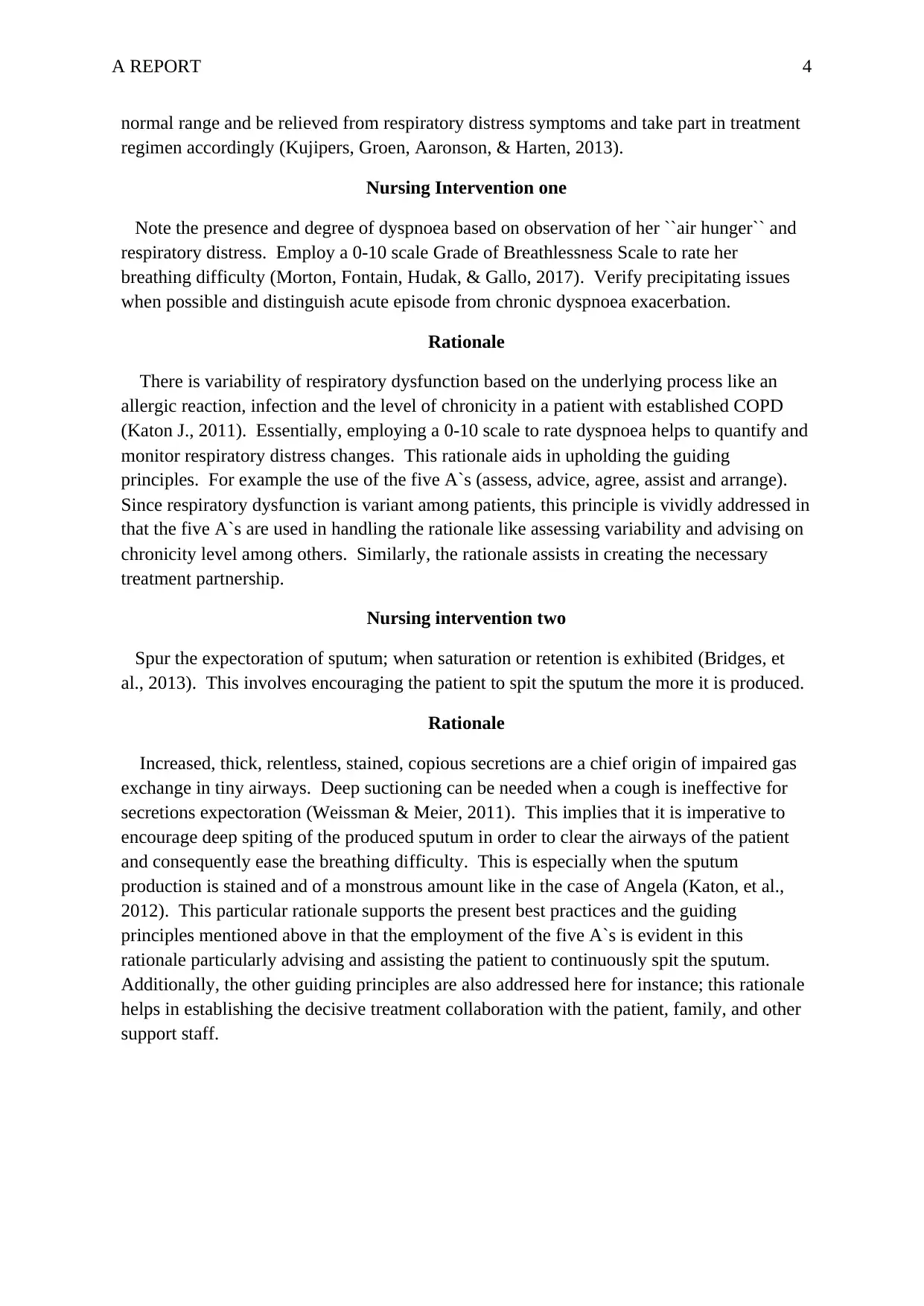
A REPORT 4
normal range and be relieved from respiratory distress symptoms and take part in treatment
regimen accordingly (Kujipers, Groen, Aaronson, & Harten, 2013).
Nursing Intervention one
Note the presence and degree of dyspnoea based on observation of her ``air hunger`` and
respiratory distress. Employ a 0-10 scale Grade of Breathlessness Scale to rate her
breathing difficulty (Morton, Fontain, Hudak, & Gallo, 2017). Verify precipitating issues
when possible and distinguish acute episode from chronic dyspnoea exacerbation.
Rationale
There is variability of respiratory dysfunction based on the underlying process like an
allergic reaction, infection and the level of chronicity in a patient with established COPD
(Katon J., 2011). Essentially, employing a 0-10 scale to rate dyspnoea helps to quantify and
monitor respiratory distress changes. This rationale aids in upholding the guiding
principles. For example the use of the five A`s (assess, advice, agree, assist and arrange).
Since respiratory dysfunction is variant among patients, this principle is vividly addressed in
that the five A`s are used in handling the rationale like assessing variability and advising on
chronicity level among others. Similarly, the rationale assists in creating the necessary
treatment partnership.
Nursing intervention two
Spur the expectoration of sputum; when saturation or retention is exhibited (Bridges, et
al., 2013). This involves encouraging the patient to spit the sputum the more it is produced.
Rationale
Increased, thick, relentless, stained, copious secretions are a chief origin of impaired gas
exchange in tiny airways. Deep suctioning can be needed when a cough is ineffective for
secretions expectoration (Weissman & Meier, 2011). This implies that it is imperative to
encourage deep spiting of the produced sputum in order to clear the airways of the patient
and consequently ease the breathing difficulty. This is especially when the sputum
production is stained and of a monstrous amount like in the case of Angela (Katon, et al.,
2012). This particular rationale supports the present best practices and the guiding
principles mentioned above in that the employment of the five A`s is evident in this
rationale particularly advising and assisting the patient to continuously spit the sputum.
Additionally, the other guiding principles are also addressed here for instance; this rationale
helps in establishing the decisive treatment collaboration with the patient, family, and other
support staff.
normal range and be relieved from respiratory distress symptoms and take part in treatment
regimen accordingly (Kujipers, Groen, Aaronson, & Harten, 2013).
Nursing Intervention one
Note the presence and degree of dyspnoea based on observation of her ``air hunger`` and
respiratory distress. Employ a 0-10 scale Grade of Breathlessness Scale to rate her
breathing difficulty (Morton, Fontain, Hudak, & Gallo, 2017). Verify precipitating issues
when possible and distinguish acute episode from chronic dyspnoea exacerbation.
Rationale
There is variability of respiratory dysfunction based on the underlying process like an
allergic reaction, infection and the level of chronicity in a patient with established COPD
(Katon J., 2011). Essentially, employing a 0-10 scale to rate dyspnoea helps to quantify and
monitor respiratory distress changes. This rationale aids in upholding the guiding
principles. For example the use of the five A`s (assess, advice, agree, assist and arrange).
Since respiratory dysfunction is variant among patients, this principle is vividly addressed in
that the five A`s are used in handling the rationale like assessing variability and advising on
chronicity level among others. Similarly, the rationale assists in creating the necessary
treatment partnership.
Nursing intervention two
Spur the expectoration of sputum; when saturation or retention is exhibited (Bridges, et
al., 2013). This involves encouraging the patient to spit the sputum the more it is produced.
Rationale
Increased, thick, relentless, stained, copious secretions are a chief origin of impaired gas
exchange in tiny airways. Deep suctioning can be needed when a cough is ineffective for
secretions expectoration (Weissman & Meier, 2011). This implies that it is imperative to
encourage deep spiting of the produced sputum in order to clear the airways of the patient
and consequently ease the breathing difficulty. This is especially when the sputum
production is stained and of a monstrous amount like in the case of Angela (Katon, et al.,
2012). This particular rationale supports the present best practices and the guiding
principles mentioned above in that the employment of the five A`s is evident in this
rationale particularly advising and assisting the patient to continuously spit the sputum.
Additionally, the other guiding principles are also addressed here for instance; this rationale
helps in establishing the decisive treatment collaboration with the patient, family, and other
support staff.
Secure Best Marks with AI Grader
Need help grading? Try our AI Grader for instant feedback on your assignments.
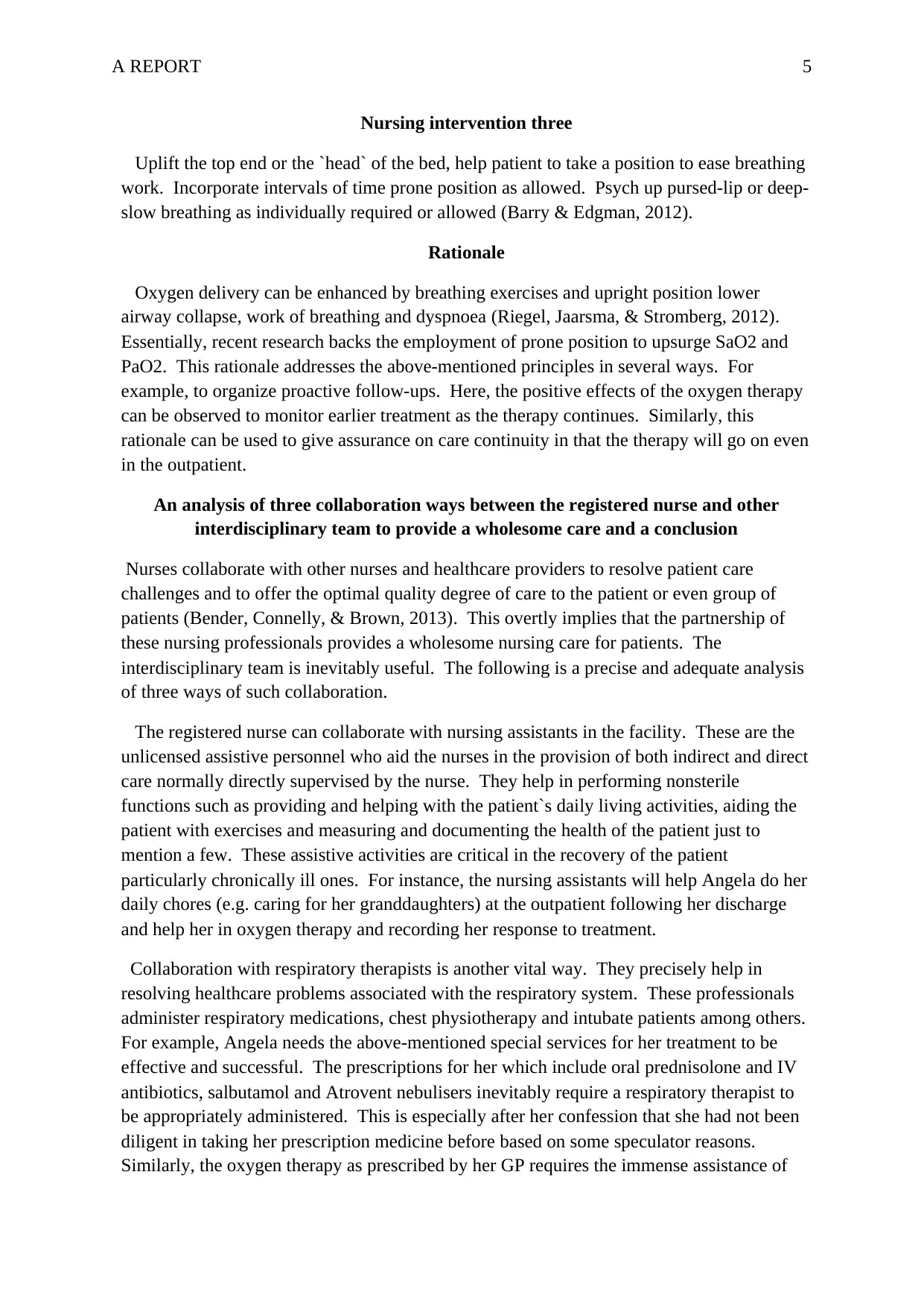
A REPORT 5
Nursing intervention three
Uplift the top end or the `head` of the bed, help patient to take a position to ease breathing
work. Incorporate intervals of time prone position as allowed. Psych up pursed-lip or deep-
slow breathing as individually required or allowed (Barry & Edgman, 2012).
Rationale
Oxygen delivery can be enhanced by breathing exercises and upright position lower
airway collapse, work of breathing and dyspnoea (Riegel, Jaarsma, & Stromberg, 2012).
Essentially, recent research backs the employment of prone position to upsurge SaO2 and
PaO2. This rationale addresses the above-mentioned principles in several ways. For
example, to organize proactive follow-ups. Here, the positive effects of the oxygen therapy
can be observed to monitor earlier treatment as the therapy continues. Similarly, this
rationale can be used to give assurance on care continuity in that the therapy will go on even
in the outpatient.
An analysis of three collaboration ways between the registered nurse and other
interdisciplinary team to provide a wholesome care and a conclusion
Nurses collaborate with other nurses and healthcare providers to resolve patient care
challenges and to offer the optimal quality degree of care to the patient or even group of
patients (Bender, Connelly, & Brown, 2013). This overtly implies that the partnership of
these nursing professionals provides a wholesome nursing care for patients. The
interdisciplinary team is inevitably useful. The following is a precise and adequate analysis
of three ways of such collaboration.
The registered nurse can collaborate with nursing assistants in the facility. These are the
unlicensed assistive personnel who aid the nurses in the provision of both indirect and direct
care normally directly supervised by the nurse. They help in performing nonsterile
functions such as providing and helping with the patient`s daily living activities, aiding the
patient with exercises and measuring and documenting the health of the patient just to
mention a few. These assistive activities are critical in the recovery of the patient
particularly chronically ill ones. For instance, the nursing assistants will help Angela do her
daily chores (e.g. caring for her granddaughters) at the outpatient following her discharge
and help her in oxygen therapy and recording her response to treatment.
Collaboration with respiratory therapists is another vital way. They precisely help in
resolving healthcare problems associated with the respiratory system. These professionals
administer respiratory medications, chest physiotherapy and intubate patients among others.
For example, Angela needs the above-mentioned special services for her treatment to be
effective and successful. The prescriptions for her which include oral prednisolone and IV
antibiotics, salbutamol and Atrovent nebulisers inevitably require a respiratory therapist to
be appropriately administered. This is especially after her confession that she had not been
diligent in taking her prescription medicine before based on some speculator reasons.
Similarly, the oxygen therapy as prescribed by her GP requires the immense assistance of
Nursing intervention three
Uplift the top end or the `head` of the bed, help patient to take a position to ease breathing
work. Incorporate intervals of time prone position as allowed. Psych up pursed-lip or deep-
slow breathing as individually required or allowed (Barry & Edgman, 2012).
Rationale
Oxygen delivery can be enhanced by breathing exercises and upright position lower
airway collapse, work of breathing and dyspnoea (Riegel, Jaarsma, & Stromberg, 2012).
Essentially, recent research backs the employment of prone position to upsurge SaO2 and
PaO2. This rationale addresses the above-mentioned principles in several ways. For
example, to organize proactive follow-ups. Here, the positive effects of the oxygen therapy
can be observed to monitor earlier treatment as the therapy continues. Similarly, this
rationale can be used to give assurance on care continuity in that the therapy will go on even
in the outpatient.
An analysis of three collaboration ways between the registered nurse and other
interdisciplinary team to provide a wholesome care and a conclusion
Nurses collaborate with other nurses and healthcare providers to resolve patient care
challenges and to offer the optimal quality degree of care to the patient or even group of
patients (Bender, Connelly, & Brown, 2013). This overtly implies that the partnership of
these nursing professionals provides a wholesome nursing care for patients. The
interdisciplinary team is inevitably useful. The following is a precise and adequate analysis
of three ways of such collaboration.
The registered nurse can collaborate with nursing assistants in the facility. These are the
unlicensed assistive personnel who aid the nurses in the provision of both indirect and direct
care normally directly supervised by the nurse. They help in performing nonsterile
functions such as providing and helping with the patient`s daily living activities, aiding the
patient with exercises and measuring and documenting the health of the patient just to
mention a few. These assistive activities are critical in the recovery of the patient
particularly chronically ill ones. For instance, the nursing assistants will help Angela do her
daily chores (e.g. caring for her granddaughters) at the outpatient following her discharge
and help her in oxygen therapy and recording her response to treatment.
Collaboration with respiratory therapists is another vital way. They precisely help in
resolving healthcare problems associated with the respiratory system. These professionals
administer respiratory medications, chest physiotherapy and intubate patients among others.
For example, Angela needs the above-mentioned special services for her treatment to be
effective and successful. The prescriptions for her which include oral prednisolone and IV
antibiotics, salbutamol and Atrovent nebulisers inevitably require a respiratory therapist to
be appropriately administered. This is especially after her confession that she had not been
diligent in taking her prescription medicine before based on some speculator reasons.
Similarly, the oxygen therapy as prescribed by her GP requires the immense assistance of
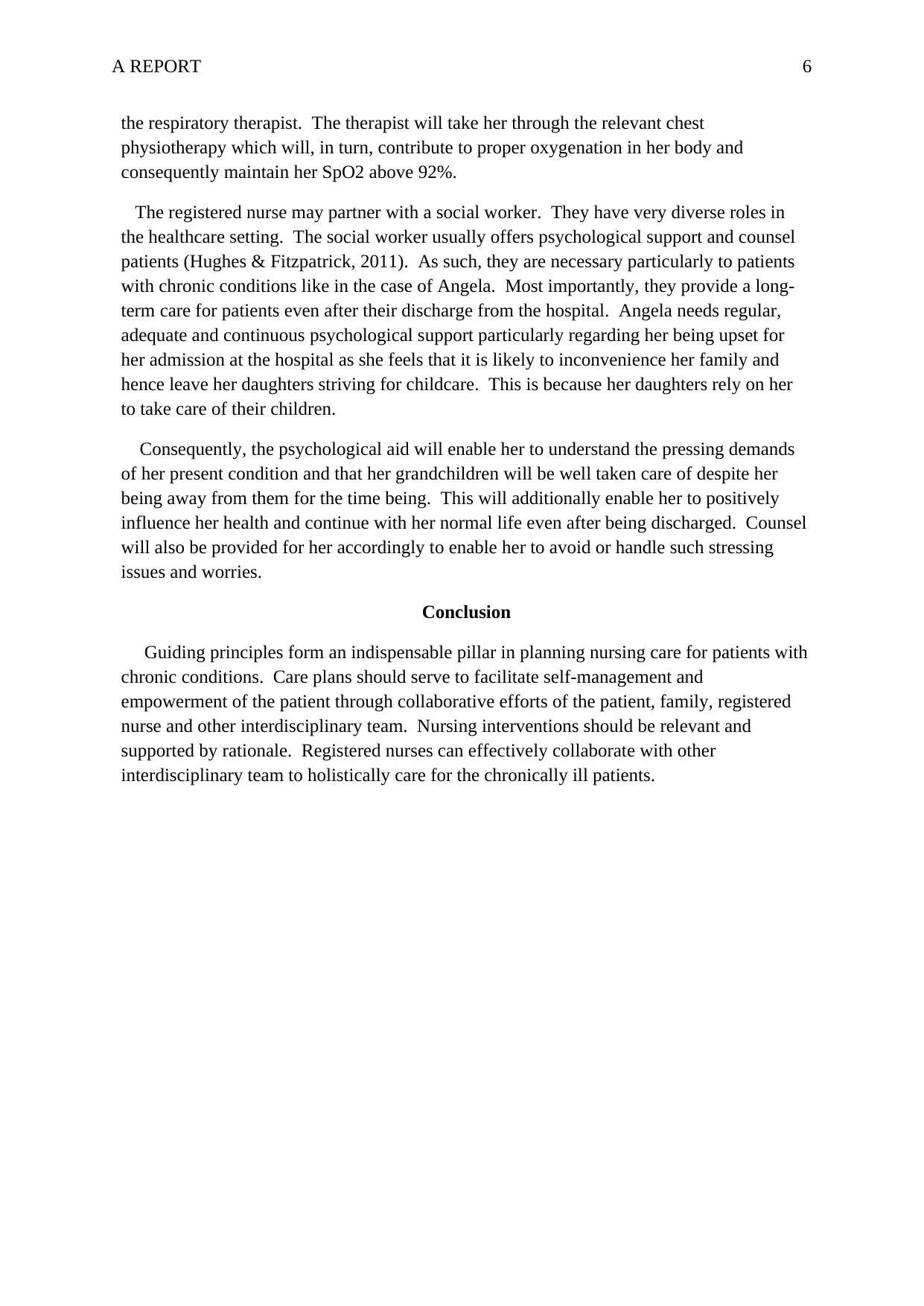
A REPORT 6
the respiratory therapist. The therapist will take her through the relevant chest
physiotherapy which will, in turn, contribute to proper oxygenation in her body and
consequently maintain her SpO2 above 92%.
The registered nurse may partner with a social worker. They have very diverse roles in
the healthcare setting. The social worker usually offers psychological support and counsel
patients (Hughes & Fitzpatrick, 2011). As such, they are necessary particularly to patients
with chronic conditions like in the case of Angela. Most importantly, they provide a long-
term care for patients even after their discharge from the hospital. Angela needs regular,
adequate and continuous psychological support particularly regarding her being upset for
her admission at the hospital as she feels that it is likely to inconvenience her family and
hence leave her daughters striving for childcare. This is because her daughters rely on her
to take care of their children.
Consequently, the psychological aid will enable her to understand the pressing demands
of her present condition and that her grandchildren will be well taken care of despite her
being away from them for the time being. This will additionally enable her to positively
influence her health and continue with her normal life even after being discharged. Counsel
will also be provided for her accordingly to enable her to avoid or handle such stressing
issues and worries.
Conclusion
Guiding principles form an indispensable pillar in planning nursing care for patients with
chronic conditions. Care plans should serve to facilitate self-management and
empowerment of the patient through collaborative efforts of the patient, family, registered
nurse and other interdisciplinary team. Nursing interventions should be relevant and
supported by rationale. Registered nurses can effectively collaborate with other
interdisciplinary team to holistically care for the chronically ill patients.
the respiratory therapist. The therapist will take her through the relevant chest
physiotherapy which will, in turn, contribute to proper oxygenation in her body and
consequently maintain her SpO2 above 92%.
The registered nurse may partner with a social worker. They have very diverse roles in
the healthcare setting. The social worker usually offers psychological support and counsel
patients (Hughes & Fitzpatrick, 2011). As such, they are necessary particularly to patients
with chronic conditions like in the case of Angela. Most importantly, they provide a long-
term care for patients even after their discharge from the hospital. Angela needs regular,
adequate and continuous psychological support particularly regarding her being upset for
her admission at the hospital as she feels that it is likely to inconvenience her family and
hence leave her daughters striving for childcare. This is because her daughters rely on her
to take care of their children.
Consequently, the psychological aid will enable her to understand the pressing demands
of her present condition and that her grandchildren will be well taken care of despite her
being away from them for the time being. This will additionally enable her to positively
influence her health and continue with her normal life even after being discharged. Counsel
will also be provided for her accordingly to enable her to avoid or handle such stressing
issues and worries.
Conclusion
Guiding principles form an indispensable pillar in planning nursing care for patients with
chronic conditions. Care plans should serve to facilitate self-management and
empowerment of the patient through collaborative efforts of the patient, family, registered
nurse and other interdisciplinary team. Nursing interventions should be relevant and
supported by rationale. Registered nurses can effectively collaborate with other
interdisciplinary team to holistically care for the chronically ill patients.
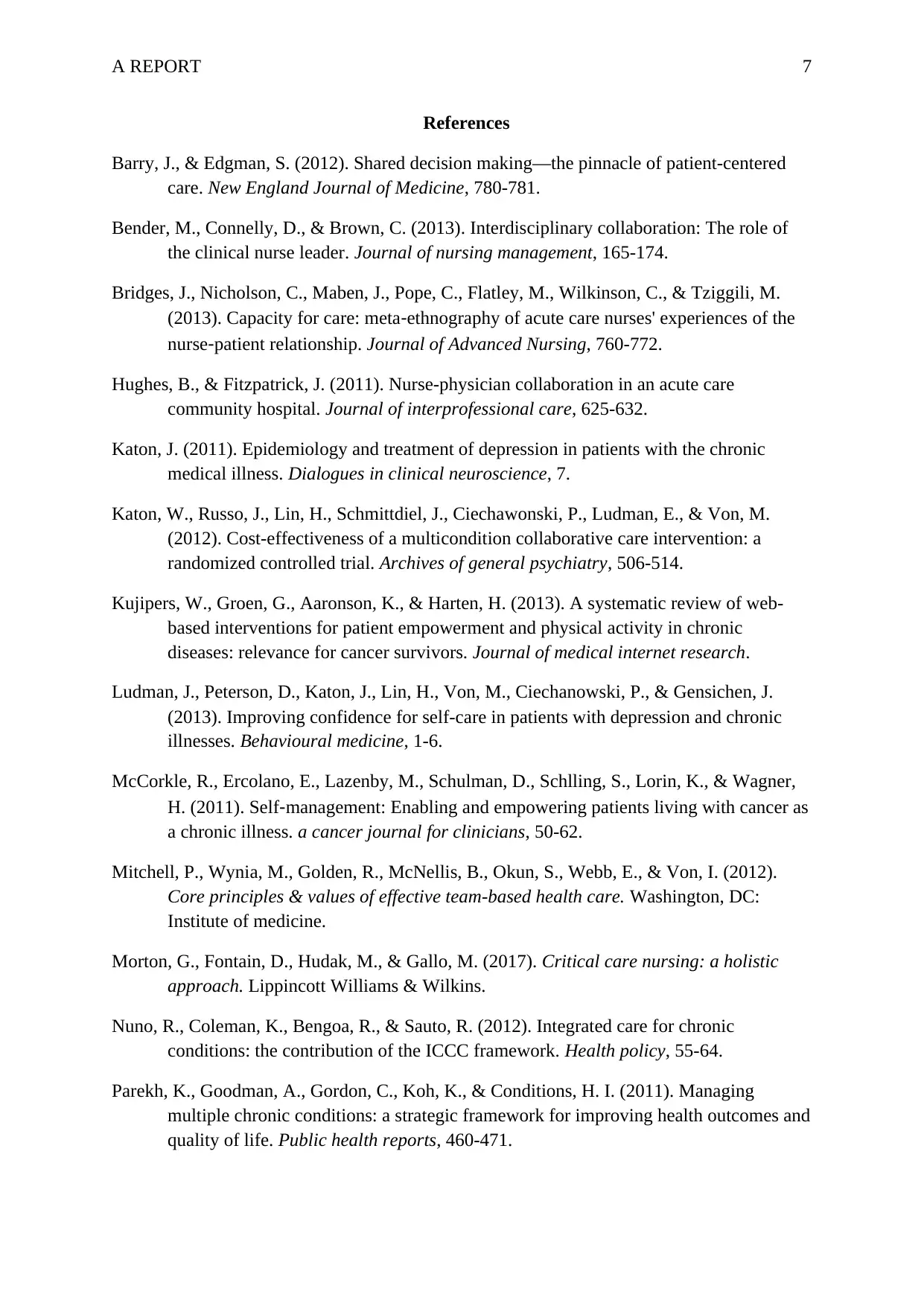
A REPORT 7
References
Barry, J., & Edgman, S. (2012). Shared decision making—the pinnacle of patient-centered
care. New England Journal of Medicine, 780-781.
Bender, M., Connelly, D., & Brown, C. (2013). Interdisciplinary collaboration: The role of
the clinical nurse leader. Journal of nursing management, 165-174.
Bridges, J., Nicholson, C., Maben, J., Pope, C., Flatley, M., Wilkinson, C., & Tziggili, M.
(2013). Capacity for care: meta‐ethnography of acute care nurses' experiences of the
nurse‐patient relationship. Journal of Advanced Nursing, 760-772.
Hughes, B., & Fitzpatrick, J. (2011). Nurse-physician collaboration in an acute care
community hospital. Journal of interprofessional care, 625-632.
Katon, J. (2011). Epidemiology and treatment of depression in patients with the chronic
medical illness. Dialogues in clinical neuroscience, 7.
Katon, W., Russo, J., Lin, H., Schmittdiel, J., Ciechawonski, P., Ludman, E., & Von, M.
(2012). Cost-effectiveness of a multicondition collaborative care intervention: a
randomized controlled trial. Archives of general psychiatry, 506-514.
Kujipers, W., Groen, G., Aaronson, K., & Harten, H. (2013). A systematic review of web-
based interventions for patient empowerment and physical activity in chronic
diseases: relevance for cancer survivors. Journal of medical internet research.
Ludman, J., Peterson, D., Katon, J., Lin, H., Von, M., Ciechanowski, P., & Gensichen, J.
(2013). Improving confidence for self-care in patients with depression and chronic
illnesses. Behavioural medicine, 1-6.
McCorkle, R., Ercolano, E., Lazenby, M., Schulman, D., Schlling, S., Lorin, K., & Wagner,
H. (2011). Self‐management: Enabling and empowering patients living with cancer as
a chronic illness. a cancer journal for clinicians, 50-62.
Mitchell, P., Wynia, M., Golden, R., McNellis, B., Okun, S., Webb, E., & Von, I. (2012).
Core principles & values of effective team-based health care. Washington, DC:
Institute of medicine.
Morton, G., Fontain, D., Hudak, M., & Gallo, M. (2017). Critical care nursing: a holistic
approach. Lippincott Williams & Wilkins.
Nuno, R., Coleman, K., Bengoa, R., & Sauto, R. (2012). Integrated care for chronic
conditions: the contribution of the ICCC framework. Health policy, 55-64.
Parekh, K., Goodman, A., Gordon, C., Koh, K., & Conditions, H. I. (2011). Managing
multiple chronic conditions: a strategic framework for improving health outcomes and
quality of life. Public health reports, 460-471.
References
Barry, J., & Edgman, S. (2012). Shared decision making—the pinnacle of patient-centered
care. New England Journal of Medicine, 780-781.
Bender, M., Connelly, D., & Brown, C. (2013). Interdisciplinary collaboration: The role of
the clinical nurse leader. Journal of nursing management, 165-174.
Bridges, J., Nicholson, C., Maben, J., Pope, C., Flatley, M., Wilkinson, C., & Tziggili, M.
(2013). Capacity for care: meta‐ethnography of acute care nurses' experiences of the
nurse‐patient relationship. Journal of Advanced Nursing, 760-772.
Hughes, B., & Fitzpatrick, J. (2011). Nurse-physician collaboration in an acute care
community hospital. Journal of interprofessional care, 625-632.
Katon, J. (2011). Epidemiology and treatment of depression in patients with the chronic
medical illness. Dialogues in clinical neuroscience, 7.
Katon, W., Russo, J., Lin, H., Schmittdiel, J., Ciechawonski, P., Ludman, E., & Von, M.
(2012). Cost-effectiveness of a multicondition collaborative care intervention: a
randomized controlled trial. Archives of general psychiatry, 506-514.
Kujipers, W., Groen, G., Aaronson, K., & Harten, H. (2013). A systematic review of web-
based interventions for patient empowerment and physical activity in chronic
diseases: relevance for cancer survivors. Journal of medical internet research.
Ludman, J., Peterson, D., Katon, J., Lin, H., Von, M., Ciechanowski, P., & Gensichen, J.
(2013). Improving confidence for self-care in patients with depression and chronic
illnesses. Behavioural medicine, 1-6.
McCorkle, R., Ercolano, E., Lazenby, M., Schulman, D., Schlling, S., Lorin, K., & Wagner,
H. (2011). Self‐management: Enabling and empowering patients living with cancer as
a chronic illness. a cancer journal for clinicians, 50-62.
Mitchell, P., Wynia, M., Golden, R., McNellis, B., Okun, S., Webb, E., & Von, I. (2012).
Core principles & values of effective team-based health care. Washington, DC:
Institute of medicine.
Morton, G., Fontain, D., Hudak, M., & Gallo, M. (2017). Critical care nursing: a holistic
approach. Lippincott Williams & Wilkins.
Nuno, R., Coleman, K., Bengoa, R., & Sauto, R. (2012). Integrated care for chronic
conditions: the contribution of the ICCC framework. Health policy, 55-64.
Parekh, K., Goodman, A., Gordon, C., Koh, K., & Conditions, H. I. (2011). Managing
multiple chronic conditions: a strategic framework for improving health outcomes and
quality of life. Public health reports, 460-471.
Paraphrase This Document
Need a fresh take? Get an instant paraphrase of this document with our AI Paraphraser
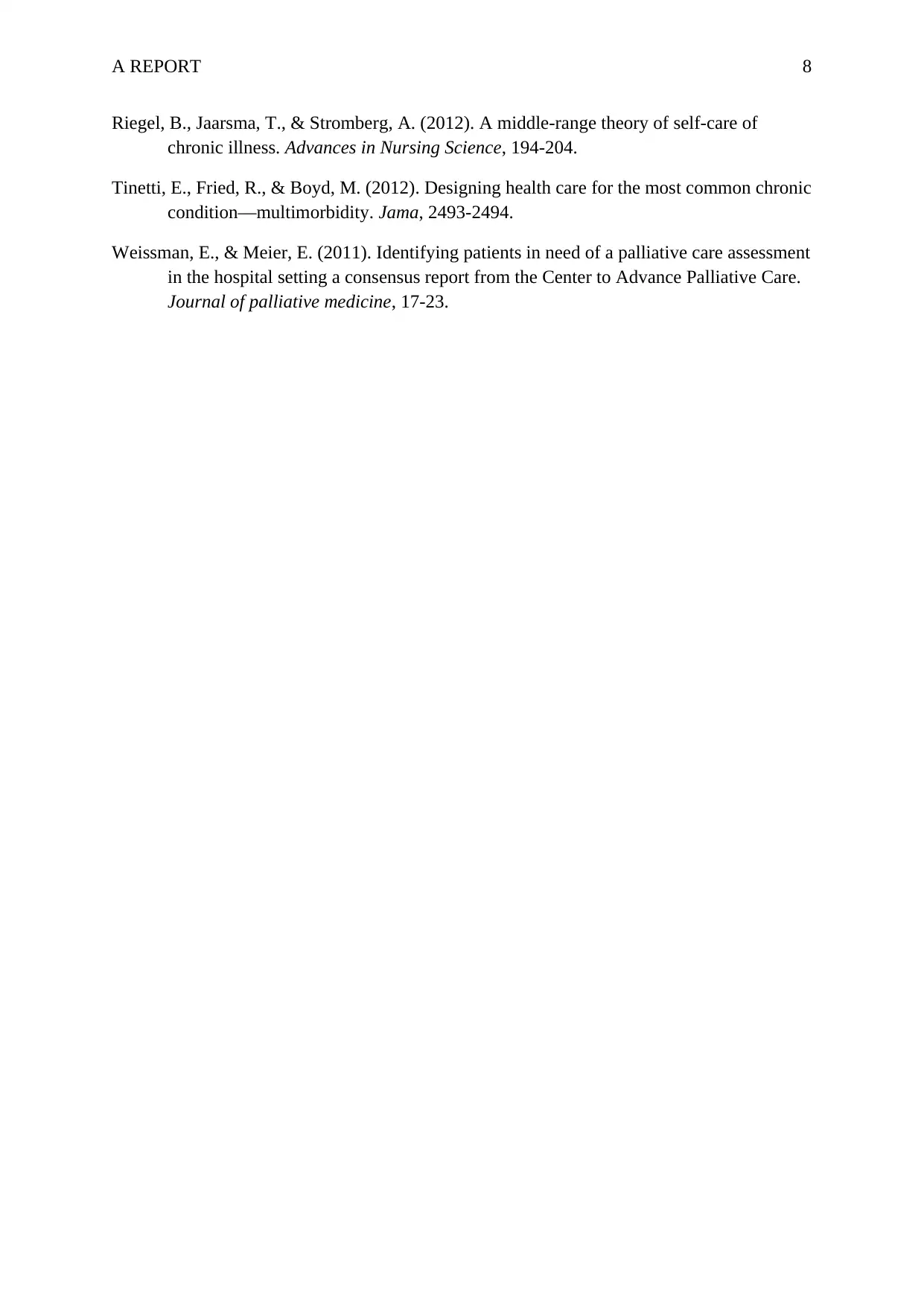
A REPORT 8
Riegel, B., Jaarsma, T., & Stromberg, A. (2012). A middle-range theory of self-care of
chronic illness. Advances in Nursing Science, 194-204.
Tinetti, E., Fried, R., & Boyd, M. (2012). Designing health care for the most common chronic
condition—multimorbidity. Jama, 2493-2494.
Weissman, E., & Meier, E. (2011). Identifying patients in need of a palliative care assessment
in the hospital setting a consensus report from the Center to Advance Palliative Care.
Journal of palliative medicine, 17-23.
Riegel, B., Jaarsma, T., & Stromberg, A. (2012). A middle-range theory of self-care of
chronic illness. Advances in Nursing Science, 194-204.
Tinetti, E., Fried, R., & Boyd, M. (2012). Designing health care for the most common chronic
condition—multimorbidity. Jama, 2493-2494.
Weissman, E., & Meier, E. (2011). Identifying patients in need of a palliative care assessment
in the hospital setting a consensus report from the Center to Advance Palliative Care.
Journal of palliative medicine, 17-23.
1 out of 8
Related Documents
Your All-in-One AI-Powered Toolkit for Academic Success.
+13062052269
info@desklib.com
Available 24*7 on WhatsApp / Email
![[object Object]](/_next/static/media/star-bottom.7253800d.svg)
Unlock your academic potential
© 2024 | Zucol Services PVT LTD | All rights reserved.





